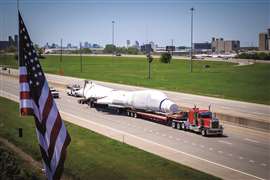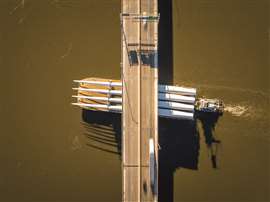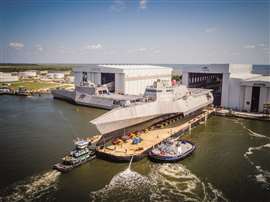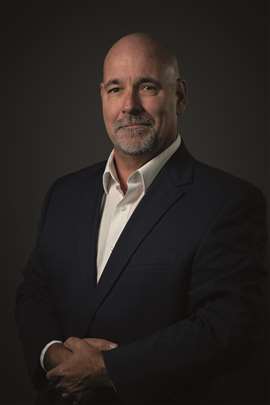What are the benefits of drones in specialized transport?
05 February 2024
Drones have certainly become a great tool in the heavy transportation industry and the construction industry at large. Before drones were readily available to the masses, companies would hire a helicopter and a photographer to shoot a project. It was a costly endeavor, especially when project budgets were tight.
 While drone photography and video are great tools for imagery, they can also assist the project team with height clearances to help with final positioning, rigging inspections, load securement from an overhead perspective and more. PHOTO: Tony Broussard
While drone photography and video are great tools for imagery, they can also assist the project team with height clearances to help with final positioning, rigging inspections, load securement from an overhead perspective and more. PHOTO: Tony Broussard
“Filming heavy transport projects for the past 16 years, I had to use a man lift when I wanted an elevated project shot,” said Preeminent Marketing Group owner Tony Broussard, who has captured through drone photography some of the most impressive heavy transport projects across the United States. “While this method served the purpose, you were limited to where you could position yourself, and many times, you couldn’t get the shots you wanted. When drones came on the scene, I immediately recognized how useful they could be to my workflow.”
Having an aerial camera platform that could be positioned anywhere brought a new level of photo and video capture possibilities, Broussard said.
“With a drone, I could now capture images and video footage of load-outs from across a river as well as get all angles of a project,” he said. “It soon became one of the most useful tools in my equipment arsenal.”
Over-the-road transport can sometimes be ordinary and unimpressive, but sometimes there are extraordinary projects that a company wants to capture along the route, Broussard said. Drones do an excellent job at capturing the transport project’s progress.
 PHOTO: Tony Broussard
PHOTO: Tony Broussard
“One thing about over-the-road transports is that they sometimes route through some great-looking scenery that makes for beautiful wall-hanger-worthy images,” said Broussard. “Having a drone on the job allows me to grab many great photo opportunities, especially when the transport rolls through picturesque small towns.”
Scenic photos, plus
A drone is a tool that is great for imagery, but it can also be used to assist the specialized transport team in several aspects of the project: height clearances to help with final positioning, rigging inspections, load securement from an overhead perspective and more.
“On many over-the-road transport projects, I’ve used the drone to help clear traffic lights, low-hanging trees and underpasses,” said Broussard. “The bucket trucks working with us do a great job at this, but having a drone is like having an extra set of eyes to double-check things, which is a great sense of security for the team.”
On much larger offshore topside load-out projects, Broussard has used the live video feed to assist with an overhead view that can help the SPMT operator line up the cargo before it gets to the ramps and onto the barge. He explained that the overhead perspective can help with many safety concerns.
By providing a 360-degree view, drones can chronicle the progress of a project or construction site. Zoom functions allow the photographer or videographer to capture high-resolution images. As well, photographers no longer have to climb up on equipment or buildings to view the subject.
Drone images can help capture data that can be used to develop 3D maps that provide a better perspective for contractors to see progress from one timeframe to another. Potential problems can be identified quickly as well as safety issues eliminated.
Overhead safety
While drones are a valuable tool, one must be safe while operating them on the jobsite and along transport routes. Drone photographers must be highly trained in operating a drone over a jobsite, and many times FAA and other governmental clearances must be achieved.
 PHOTO: Tony Broussard
PHOTO: Tony Broussard
“When I arrive on load-out projects, I survey the area and take notice of the surroundings, especially when cranes are on site,” Broussard said. “The crane boom that you thought was in one place has now moved location or has boomed up higher, so the altitude clearance you thought you had initially has now changed. It’s an ever-evolving scene that you need to be mindful of.”
On over-the-road transports often travel a route that the photographer has not “pre-tripped,” which can pose many challenges.
“Everywhere along the route, you must be aware of obstacles that can be hazardous, such as high-voltage power lines, towers and tall buildings,” he said. “Staying vigilant is critical to making sure your drone doesn’t have a collision.
“You have to be quick to get set up because the load is coming to you, and you only have one chance to get that incredible shot at that location, but you have to place safety above all else,” Broussard said. “Getting a great photo isn’t worth it if something bad happens.”
ABOUT TONY BROUSSARD

In the marketing and media business for over 24 years, Tony Broussard, owner and founder of Preeminent Marketing Group, has captured important and impressive heavy transport projects across the United States. His photography has been featured in several issues and on covers of American Cranes & Transport, as well as such magazines as Workboat and Ducks Unlimited.
Broussard’s work has also been featured in advertising media for Goldhofer and Faymonville, and well as other OEMs. Broussard filmed breakbulk shipment offloads and transfer projects at several U.S. ports for deugro Group, Trans Global, DHL and other international freight forwarding companies. He has also shot Antonov and Boeing 747 cargo aircraft offload operations.
He has also photographed many large tilt-wall construction and shipyard projects.
He filmed the loading and entire Mississippi River transit of the largest wind blade shipment from the Port of New Orleans. He has nearly ten years of professional drone photography and cinematography experience and is FAA-certified.
His knack for remote-controlled aircraft comes naturally. When he was 15, his father, a master boat builder, designed and built his own brand of remote-controlled outrigger hydroplane boats capable of 100 mph that were sold worldwide.
“My dad was a great example of a true craftsman, and he instilled in me the virtue of being the best at whatever you do, a life lesson in my work.”
STAY CONNECTED


Receive the information you need when you need it through our world-leading magazines, newsletters and daily briefings.




